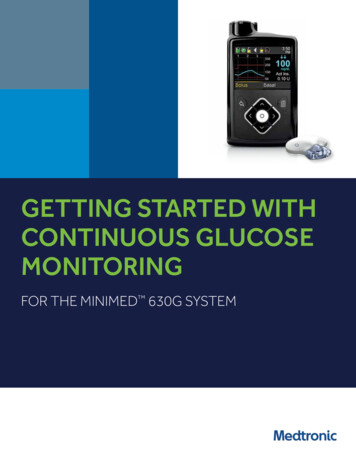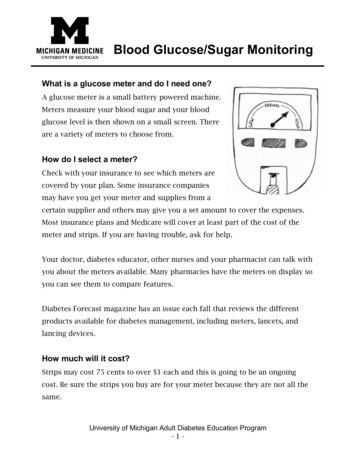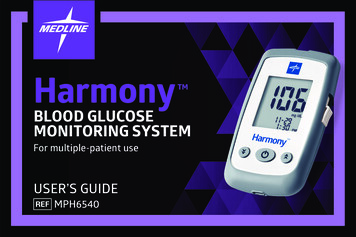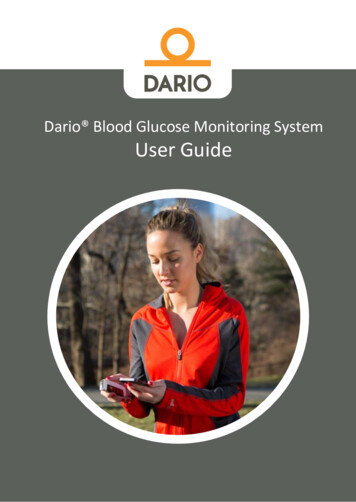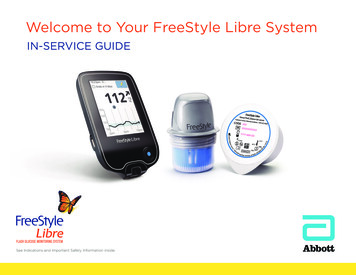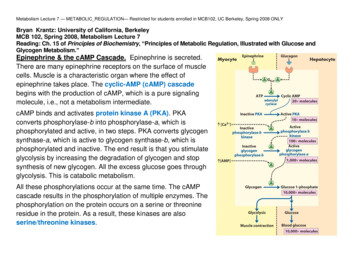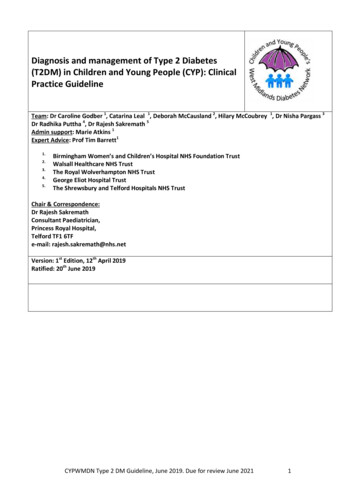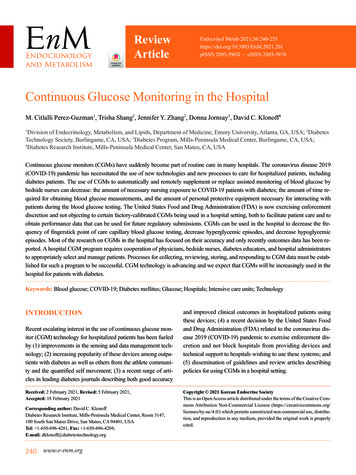
Transcription
ReviewArticleEndocrinol Metab 1pISSN 2093-596X · eISSN 2093-5978Continuous Glucose Monitoring in the HospitalM. Citlalli Perez-Guzman1, Trisha Shang2, Jennifer Y. Zhang2, Donna Jornsay3, David C. Klonoff4Division of Endocrinology, Metabolism, and Lipids, Department of Medicine, Emory University, Atlanta, GA, USA; 2DiabetesTechnology Society, Burlingame, CA, USA; 3Diabetes Program, Mills-Peninsula Medical Center, Burlingame, CA, USA;4Diabetes Research Institute, Mills-Peninsula Medical Center, San Mateo, CA, USA1Continuous glucose monitors (CGMs) have suddenly become part of routine care in many hospitals. The coronavirus disease 2019(COVID-19) pandemic has necessitated the use of new technologies and new processes to care for hospitalized patients, includingdiabetes patients. The use of CGMs to automatically and remotely supplement or replace assisted monitoring of blood glucose bybedside nurses can decrease: the amount of necessary nursing exposure to COVID-19 patients with diabetes; the amount of time required for obtaining blood glucose measurements, and the amount of personal protective equipment necessary for interacting withpatients during the blood glucose testing. The United States Food and Drug Administration (FDA) is now exercising enforcementdiscretion and not objecting to certain factory-calibrated CGMs being used in a hospital setting, both to facilitate patient care and toobtain performance data that can be used for future regulatory submissions. CGMs can be used in the hospital to decrease the frequency of fingerstick point of care capillary blood glucose testing, decrease hyperglycemic episodes, and decrease hypoglycemicepisodes. Most of the research on CGMs in the hospital has focused on their accuracy and only recently outcomes data has been reported. A hospital CGM program requires cooperation of physicians, bedside nurses, diabetes educators, and hospital administratorsto appropriately select and manage patients. Processes for collecting, reviewing, storing, and responding to CGM data must be established for such a program to be successful. CGM technology is advancing and we expect that CGMs will be increasingly used in thehospital for patients with diabetes.Keywords: Blood glucose; COVID-19; Diabetes mellitus; Glucose; Hospitals; Intensive care units; TechnologyINTRODUCTIONRecent escalating interest in the use of continuous glucose monitor (CGM) technology for hospitalized patients has been fueledby (1) improvements in the sensing and data management technology; (2) increasing popularity of these devices among outpatients with diabetes as well as others from the athlete community and the quantified self movement; (3) a recent surge of articles in leading diabetes journals describing both good accuracyReceived: 2 February 2021, Revised: 5 February 2021,Accepted: 18 February 2021Corresponding author: David C. KlonoffDiabetes Research Institute, Mills-Peninsula Medical Center, Room 5147,100 South San Mateo Drive, San Mateo, CA 94401, USATel: 1-650-696-4261, Fax: 1-650-696-4269,E-mail: dklonoff@diabetestechnology.org240 www.e-enm.organd improved clinical outcomes in hospitalized patients usingthese devices; (4) a recent decision by the United States Foodand Drug Administration (FDA) related to the coronavirus disease 2019 (COVID-19) pandemic to exercise enforcement discretion and not block hospitals from providing devices andtechnical support to hospitals wishing to use these systems; and(5) dissemination of guidelines and review articles describingpolicies for using CGMs in a hospital setting.Copyright 2021 Korean Endocrine SocietyThis is an Open Access article distributed under the terms of the Creative Com mons Attribution Non-Commercial License (https://creativecommons.org/licenses/by-nc/4.0/) which permits unrestricted non-commercial use, distribu tion, and reproduction in any medium, provided the original work is properlycited.
Continuous Glucose Monitoring in HospitalDEFINITION OF A CONTINUOUS GLUCOSEMONITORA CGM is a device that measures the glucose concentration automatically around the clock [1]. The device must be attached tothe body in some way and it can be either a wearable device oran implanted device. A CGM sensor can be situated in the subcutaneous space to measure the glucose concentration in interstitial fluid (ISF) or in a blood vessel and measure the glucoseconcentration in blood. Intravascular sensors are rarely used andconfer a risk of bleeding and thrombosis and will not be coveredin this article. Subcutaneous glucose sensors can require calibration anywhere from not at all up to four times daily [2]. One ofthe advantages of automatic glucose measurements is the timesaved for the nurses who do not have to check blood glucoses asoften, but a disadvantage is that compared to blood glucosemonitors, these sensors track ISF glucose rather than referenceblood glucose concentrations (which are used for registrationstudies) less closely. Therefore, if a particular CGM requiresregular calibration with blood glucose testing and provides lessaccurate reading as well, then there will be little interest in usingsuch a product for hospitalized patients.A CGM sensor with two attractive features: (1) factory calibration and (2) accuracy close to that of most blood glucosemonitors (which many clinicians and mathematicians considerto be a mean absolute relative difference (MARD) from reference of below 10%) [3] would be well received in a hospitalsetting, providing there are no special accuracy concerns aboutphysiological states altering ISF composition in critically ill patients. Two currently available types of sensors, the FreeStyleLibre series (FreeStyle Libre 14 day and FreeStyle Libre 2)from Abbott Diabetes Care (Alameda, CA, USA) [4,5], and theDexcom G6 from Dexcom (San Diego, CA, USA) [6] providethese two features for most patients. The FreeStyle Libre 3 has aConformité Européenne (CE) mark, but is not cleared by theFDA. However, none of these products are cleared by the FDAfor use by critically ill hospitalized patients. Table 1 presents alist of currently available (in the United States) factory-calibrated subcutaneous CGMs that have product labels available andtheir known interferences from chemical substances [7-14].For a given glucose concentration, CGMs from differentmanufacturers might report different percentages of time spentbelow range and above range, and might generate different individual times spent below or above range that could lead to different therapy recommendations [15]. Some hospitalized patients are volume depleted or they can experience peripheral vaCopyright 2021 Korean Endocrine Societysoconstriction from pressors, and it has not been clearly established whether CGMs that are currently intended for outpatientuse can deliver adequately accurate results for these people [16].More data will be needed about the analytical accuracy ofCGMs in hospitalized patients before these devices will receiveregulatory clearance for use in this setting.With the recent COVID-19 pandemic straining hospital resources in 2020, the FDA notified Abbott Diabetes Care andDexcom that they would exercise enforcement discretion andnot object if these companies provided devices and technicalsupport to hospitals who used CGMs for off-label use [17-19].This plan has allowed many hospitals to assign nurses to usethese devices for remote monitoring of glucose concentrationsin COVID-19 patients with diabetes without needing to spendtime performing fingerstick testing, having as much contactwith contagious patients, and using up as much (in some caseslimited) personal protective equipment (PPE) during fingersticktesting. Furthermore these programs have benefitted both thesetwo manufacturers and the FDA by facilitating collection of realworld data on large numbers of patients, whereas in clinical trials of these products in a hospital setting testing protocols wouldhave been expensive and time consuming.ESTABLISHING A CGM PROGRAMThe implementation of a CGM program in the hospital demandsthe interaction of multiple stakeholders including hospital leadership, physicians (many times including endocrinologists),nursing leadership, information technologists, quality implementation officers, laboratories representatives, pharmacists,and risk management officers. Ideally, information technologyservices can facilitate the documentation of CGM in the electronic health records (EHRs) to facilitate the comparison ofpoint of care (POC) tests with CGM values and confirm periodically that CGM readings used for patient care are within an acceptable range [20]. Steps for a successful implementation inthe hospital were recently described by Galindo et al. [21].Current platforms for CGM implementation with factory-calibrated devices (that do not need a confirmatory test for decisions in the outpatient setting) include apps for the patient, appsfor remote followers of glucose values, and platforms for population-based management. The Dexcom G6 device from Dexcom can transmit glucose data via Bluetooth to a receiver orsmartphone (Android or iOS) within 20 feet. If using a compatible smartphone, then information can then be shared via the“Follow” app to up to 10 selected people, such as clinicians at awww.e-enm.org241
Perez-Guzman MC, et al.Table 1. List of Currently Available (in the United States) Factory-Calibrated Subcutaneous CGMs That Have Product Labels Availableand Their Known Interferences from Chemical SubstancesCGM systemWarm No. ofupwear,time, hr dayCan the devicebe connected toan AID system?Technical features [7]Associatedmobile appKnown interferencesfrom chemicalsubstancesAbbott DiabetesCare FreeStyleLibre 14 daysystem [8]114Range 40–500 mg/dL; no predictive alerts; glucosemeasured every minute and real-time data can beviewed by scanning sensor which holds 8 hoursof dataNoFreestyle LibreLink,LibreLinkUp [9]Ascorbic acidSalicylic acidAbbott DiabetesCare FreeStyleLibre 2 [10,11]114Range 40–400 mg/dL; optional real-time alarmsfor hypoglycemia, hyperglycemia, and signalloss; no predictive alerts, since the sensormonitors glucose every minute; real-time datacan be viewed by scanning sensor which holds8 hours of dataNoFreeStyle Libre 2app (currentlyunder FDA review), LibreLinkUp [9]Ascorbic acidDexcom G6 [12,13]210Range 40–400 mg/dL; sensor monitors glucoseevery 5 minutes; urgent low alarm (55 mg/dL)and optional hypoglycemia predictive alert,hypoglycemia and hyperglycemia thresholdalerts, and rate of change alertsYesDexcom G6 app,Follow app [14]HydroxyureaCGM, continuous glucose monitor; AID, automated insulin delivery; FDA, U.S. Food and Drug Administration.nursing station (who can use a dedicated tablet), the primarycare team, bedside nurses, pharmacists, and/or endocrinologiststhat follow remotely. The data can also be transferred to onlineplatforms, such as Dexcom CLARITY, that generates CGMbased glucose reports and summarizes data on a daily basis orover any specified period of time [14]. With the FreeStyle Libre14 day and FreeStyle Libre 2 systems, a similar approach canallow the use of this technology in the hospital. With the FreeStyle Libre 14 day system the information can be transferred toa receiver or a smartphone via the FreeStyle Librelink app,which then sends data to FreeStyle LibreView. Data on FreeStyle LibreView can be viewed by the patient and clinicians.Data can be viewed by patients via the LibreLink app, then tofollowers via the LibreLinkUp app, and then to Libreview.comto monitor multiple patients [9,22]. It should be noted that theboth of the FreeStyle Libre systems measure glucose every minute; real-time glucose data including the trend and retrospectiveinformation is available by scanning the sensor, which holds 8hours of data. The FreeStyle Libre 2 system has real-time optional alarms, which alert the user to high and low glucose levels without scanning.Even though CGMs often appear to be reliable in the hospital,we believe regular routine POC blood glucose testing is stillneeded plus additional confirmatory POC tests are neededwhen: (1) glucose values are 85 mg/dL or 300 mg/dL; (2)hypoglycemic symptoms occur; (3) glucose readings and/or242 www.e-enm.orgglucose trend arrows are not present on the monitor; (4) a blooddrop symbol appears on the monitor; (5) hemodynamic instability occurs; and (6) a patient is in the immediate postoperativeperiod.WHO IS A CANDIDATE FOR USING A CGMIN THE INTENSIVE CARE UNITReports are emerging on the use of wearable CGMs in the intensive care unit (ICU) setting during the COVID-19 pandemic.CGMs may be practical in the ICU for patients that require continuous intravenous insulin infusion, where hourly POC bloodglucose testing is not practical. CGMs can be attractive alternatives to hourly POC capillary blood glucose testing because ofthe exposure risk of healthcare workers performing assistedmonitoring of blood glucose [23], the amount of time needed todon and doff PPE in order to perform a POC capillary bloodglucose test, and the depletion of scarce PPE used up just to perform a single POC capillary blood glucose test. Also, at somehospitals there can be a shortage of POC blood glucose monitors. Careful monitoring of POC blood glucose along withCGM readings are required to identify potential mechanical interference [24], such as pressure induced sensor attenuation[25]. Table 2 presents a review of the literature of clinical trialsof CGM use in ICU settings for adult patients [26-68]. Table 3presents a review of the literature of clinical trials of CGM useCopyright 2021 Korean Endocrine Society
Continuous Glucose Monitoring in HospitalTable 2. Clinical Trials of CGM Use in ICU Settings for Adult PatientsStudyYearFirst authorcountryGoldberg et al.[30]2004USAVriesendorp et al.[31]2005Netherlands OR, SICU (n 8)Corstjens et al.[32]2006De Block et al.[33]PopulationICU (n 22)CGM measurementComparatorAccuracyCapillary by POCCGMs and MedtronicGlucoDayMiniMed andA. MenariniDiagnostics(A. MenariniDiagnosticsLtd., Florence,Italy)Accuracy andfeasibilityArterial by blood gasanalyzerNetherlands MICU (n 45)System Gold MedtronicMiniMedAccuracyArterial by blood gasanalyzer, YSI (YSI2300 STAT Plus glucoseand lactate analyzer,YSI Life Science,Yellow Springs, OH,USA) and POC2006BelgiumMICU (n 50)GlucodayA. MenariniDiagnosticsReliabilityArterialPrice et al. [34]2008UKMixed ICU (n 17)GuardianMedtronicMiniMedAccuracyArterial by blood gasanalyzer and POCLogtenberg et al.[35]2009Netherlands Cardiac surgery ICU(n 30)ParadigmMedtronicMiniMedAccuracy andglycemic controlCapillary, arterial, andvenous by POCYamashita et al.[36]2009JapanICU (n 50)STG 22Nikkiso Co. Ltd. Accuracy(Tokyo, Japan)Arterial by blood gasanalyzerRabiee et al. [37]2009USASICU/Burn (n 19)DexcomSTSDexcomAccuracy andreliabilityCapillary by POC andserum by labHolzinger et al.[38]2009AustriaMICU (n 50)System Gold MedtronicMiniMedAccuracy andreliabilityArterial by blood gasanalyzerHolzinger et al.[39]2010AustriaICU, mechanicalventilation (n 24)GuardianGlycemic control(% time at glucose 110 mg/dL),LOS, mortalityArterial by blood gasanalyzer and blindedMedtronic MiniMedSystem Gold CGMJacobs et al. [40]2010USAICU (n 29)Guardian RT MedtronicMiniMedAccuracy andfeasibilityCapillary by POCBrunner et al. [41]2011AustriaMICU (n 174)Guardian &SystemGoldMedtronicMiniMedAccuracy andreliabilityArterial by blood gasanalyzerKalmovich et al.[42]2012IsraelPerioperative cardiac System Gold Medtronicsurgery (n 32)BlindedMiniMedAccuracy andfeasibilityVenous by blood gasanalyzerLorencio et al.[43]2012SpainICU (n 41)GuardianAccuracyArterial by blood gasanalyzerKopecky et al.[44]2013CzechRepublicCardiac ICU (n 24)Guardian RT MedtronicMiniMedAccuracy andglycemic controlArterial by blood gasanalyzer and computer(enhanced modelpredictive control)algorithm aloneMedtronicMiniMedMedtronicMiniMed(Continued to the next page)Copyright 2021 Korean Endocrine Societywww.e-enm.org243
Perez-Guzman MC, et al.Table 2. ContinuedStudyYearFirst authorcountryCGM typeCGMmanufacturerLeelarathna et al.[45]2013UKNeurosurgical ICU(n 24)FreeStyleNavigatorAbbott DiabetesCareRodriguez-Quintanilla et al. [46]2013MexicoICU (n 16)Guardian RT MedtronicMiniMedTime to normoglyce- Venous and capillary bymiaPOCSchuster et al.[47]2014USASICU (n 24)GuardianMedtronicMiniMedAccuracyCapillary by POCKosiborod et al.[48]2014USACardiac ICU (n 21)SentrinoMedtronicMiniMedAccuracy andreliabilityCentral venous by POCor labBoom et al. [49]2014Netherlands MICU/SICU(n 156)FreeStyleNavigatorAbbott DiabetesCareAccuracy andglycemic controlArterial by blood gasanalyzer, and POCUmbrello et al.[50]2014ItalyOptiScanner OptiScan5000BiomedicalGlycemic controlCentral venous by bloodgas analyzer or lab(reported elsewhere)van Hooijdonket al. [51]2015Netherlands ICU (n 50)SentrinoMedtronicMiniMedAccuracy andreliabilityArterial by blood gasanalyzerSechterbergeret al. [52]2015Netherlands Cardiac ICU (n 8)FreeStyleNavigatorAbbott DiabetesCareAccuracyArterial by blood gasanalyzerPunke et al. [53]2015GermanySICU (n 14)SentrinoMedtronicMiniMedAccuracyArterial by blood gasanalyzerBallesteros et al.[54]2015SpainMICU (n 18)Soft SensorMedtronicMiniMedAccuracyCapillary by POCDe Block et al.[55]2015BelgiumMICU (n 35)GlucoDay S A. MenariniDiagnosticsAccuracy andglycemic controlArterial by blood gasanalyzer and blindedmicrodialysis-basedCGMGottschalk et al.[56]2016GermanyExtracorporealSentrinocardiac life support(n 25)AccuracyArterial by blood gasanalyzerNohra et al. [57]2016USASICU (n 23)Optiscanner Optiscan5000BiomedicalAccuracyCentral venous by YSIRighy Shinotsukaet al. [58]2016BelgiumICU (n 88)OptiScanner Optiscan5000BiomedicalAccuracyArterial by YSIWollersheim et al.[59]2016GermanyMICU (n 20)SentrinoAccuracy andfeasibilityArterial, central venous,or venous by blood gasanalyzerSchierenbecket al. [60]2017SwedenCardiac ICU (n 26)FreeStyleAbbott Diabetes AccuracyLibre SubCare andcutaneous- MaquetCGM vs.Getinge GroupEirus IntravascularArterial by blood gasanalyzer and capillaryby POCSong et al. [61]2017Republic ofKoreaOR, ICU (n 22)GuardianMedtronicMiniMedAccuracy andreliabilityArterial by blood gasanalyzerAncona et al. [62]2017AustraliaICU (n 8)FreeStyleLibreCGMAbbott DiabetesCareAccuracy andfeasibilityArterial by blood gasanalyzer or capillary byPOCPopulationMICU (n rementGlycemic controlComparatorArterial by blood gasanalyzer(Continued to the next page)244 www.e-enm.orgCopyright 2021 Korean Endocrine Society
Continuous Glucose Monitoring in HospitalTable 2. ContinuedStudyYearFirst authorcountryBochicchio et al.[63]2017USARijkenberg et al.[64]2018Nukui et al. [65]PopulationICU (n 243)CGM rOptiScanner OptiScan5000BiomedicalAccuracyArterial, central venous,or venous by YSINetherlands Mixed ICU (n 155)FreeStyleNavigatorAbbott DiabetesCareAccuracy andreliabilityArterial by blood gasanalyzer2019JapanAcute stroke (n 39)FreeStylePro CGMAbbott DiabetesCareAccuracy andefficacyCapillary by POCFurushima et al.[66]2020JapanICU (n 40)FreeStyleLibreCGMAbbott DiabetesCareDetermine the mean Arterial by blood gasamplitude of glyce- analyzermic excursionsChow et al. [67]2020USAICU (n 1)Dexcom G6DexcomAccuracyCapillary by POCand venous (methods not specified)Sadhu et al. [29]2020USAICU (n 11)GuardianMedtronicConnectMiniMedDexcom G6 DexcomAccuracy and feasibilityCapillary, venous, andarterial by POCGarelli et al. [68]2020ArgentinaICU patients withCOVID-19 (n 3)(2 other pediatricpatients were alsostudied)Dexcom G6 Dexcomfor the ICUpatient sGlycemic controlusing a newmultisensorplatformNoneAgarwal et al.[27]2020DexcomCapillary by POCUSAICU (n 47) Dexcom G6AccuracyChow et al. [28]2021USAICU patients withDexcom G6 DexcomCOVID-19 (n 30)Clinical utility andaccuracyArterial by POCPerez-Guzmanet al. [26]2021USAOR and cardiac ICU Dexcom G6 Dexcompatients withoutdiabetes undergoingscheduled or urgentcoronary arterybypass surgeryAccuracyCapillary by POCCGM, continuous glucose monitor; ICU, intensive care unit; POC, point of care; OR, operating room; SICU, surgical ICU; MICU, medical ICU; COVID-19, coronavirus disease 2019.in ICU settings for pediatric patients [68-74]. Every table in thisarticle presenting studies of CGM trials in hospital settings refers to protocols where these devices are intended to determineinsulin doses administered manually rather than by way of automated delivery. In these intended settings, patients are alreadybeing closely monitored and there is no convincing data currently that CGM technology will be useful in this setting. Furthermore, patients in an intensive care setting frequently requirepressors, which can cause peripheral vasoconstriction. It is possible that in such patients the circulation to the skin whereCopyright 2021 Korean Endocrine SocietyCGMs are placed might be decreased and the CGM readingsmight or might not be accurate. Recently, Perez-Guzman et al.[26] performed a prospective study with the Dexcom G6 in theICU, for 15 patients with stress hyperglycemia treated with continuous insulin infusion and vasopressors. The reported accuracy was a MARD of 12.9%. Agarwal et al. [27] conducted a retrospective analysis of 11 diabetes patients who were using Dexcom G6 CGMs. Their series included patients who had anasarcaand/or were receiving renal replacement therapy, vasopressors,mechanical ventilation support, or high-dose glucocorticoids.www.e-enm.org245
Perez-Guzman MC, et al.Table 3. Clinical Trials of CGM Use in ICU Settings for Pediatric PatientsFirst authorcountryType ofCGMPopulationCGMPerformance measurementmanufacturerStudyYearBridges et al. [69]2010USAICU (n 47)GuardianMedtronicMiniMedAccuracyArterial, venous, andcapillary by iSTATPOC and labSteil et al. [70]2011USACardiac ICU (n 311)GuardianMedtronicMiniMedAccuracy andhypoglycemiapreventionArterial by POC andlabPrabhudesai et al.[71]2015UKICU (n 19)GuardianMedtronicMiniMedAccuracyArterial by labKotzapanagiotouet al. [72]2020GreeceICU (n l by blood gasanalyzer capillary byPOC, biochemicalserum by labSopfe et al. [73]2020USAStem cell transplantation(n 29)FreeStyleLibre ProAbbottDiabetesCareAccuracyCentral venous by labGarelli et al. [68]2020Argentina ICU patients withCOVID-19 (n 2)(3 other adult patientswere also studied)Chesser et al. [74]2021USADexcom G6 Dexcomfor the ICUpatientsChildren with postprandial Dexcom G4hypoglycemia due to late Dexcom G5dumping syndromeDexcom G6following gastric surgeries (n 3)DexcomComparatorGlycemic control using a Nonenew multisensorplatformDiagnose hypoglycemia Nonedue to late dumpingsyndrome. Also todetermine best treatmentstrategies and feedingregimens.AID, automated insulin delivery; CGM, continuous glucose monitoring; ICU, intensive care unit; POC, point of care; COVID-19, coronavirus disease2019.The MARD of these CGMs was 12.58% [27]. In a different cohort of 30 critically ill patients, Chow et al. [28] found a decrease in mean glucose in 77% of the patients after Dexcom G6monitoring was started. For the full cohort, there was a 14% decrease (235.7 to 202.7 mg/dL, P 0.0003) in mean sensor glucose. Sadhu et al. [29] reported similar accuracy between theMedtronic Guardian Connect (Medtronic Minimed, Northridge,CA, USA) and Dexcom G6 devices in a cohort of 11 ICU patients. This ICU data is promising for eventual routine use ofCGMs in an ICU setting. However, these studies have limitations, including small sample sizes, inconsistent reference matrices (either capillary or arterial blood), and little informationon glycemic or clinical outcomes.As the information about CGMs in the ICU is evolving, wecurrently recommend using CGM in the ICU for selected candidates, such as patients with COVID-19, who (1) are treated withcontinuous intravenous insulin infusion; (2) develop steroid-in-246 www.e-enm.orgduced hyperglycemia; or (3) have medical nutrition therapy-induced hyperglycemia or high glycemic variability. We also recommend using a hybrid approach (combining CGM with periodical POC blood glucose testing) in the ICU to ensure consistent accuracy. CGM is currently not widely used for non-COVID patients outside of research settings.WHO IS A CANDIDATE FOR USING A CGMIN THE WARDSAn emerging use for CGM in the hospital will be detection andprevention of hypoglycemia on the wards among insulin-treatedpatients. This is a new application of CGM and the early evidence from trials to detect this complication of hospitalizationsare promising. Table 4 presents a review of the literature of clinical trials of CGM use in non-ICU settings for adult patients[75-89]. Ward patients sometimes need to have their ongoingCopyright 2021 Korean Endocrine Society
Continuous Glucose Monitoring in HospitalTable 4. Clinical Trials of CGM Use in Non-ICU Settings for Adult PatientsStudyYearFirst authorcountryDungan et al. [77]2012USAT1DM and T2DM (n 58), onintravenous or subcutaneousinsuliniPro systemMedtronicMiniMedAccuracyBurt et al. [78]2013AustraliaT1DM and T2DM, on basalbolus insulin (n 26)System GoldMedtronicMiniMedAccuracy and glycemic Capillary bycontrolPOCGomez et al. [79]2015ColombiaT2DM, on basal bolus insulin(n 38)iPro2 systemMedtronicMiniMedGlycemic control andhypoglycemiadetectionCapillary byPOCSchaupp et al.[80]2015AustriaT2DM, on basal bolus insulin(n 84)iPro2 systemMedtronicMiniMedAccuracyCapillary byPOCSpanakis et al.[81]2018USAT2DM, on insulin therapy(n 5)Dexcom G4CGM withShare2applicationDexcomGlucose telemetrysystem feasibilityNoneMigdal et al. [82]2020USAAdult medicine and surgerypatients with T1DM andT2DM (n 49)Dexcom (CGMtype unspecified)DexcomPrecision and accuracy Capillary byPOCShehav-Zaltzmanet al. [83]2020IsraelT1DM on CSII (n: 1) andGuardianT2DM on basal bolus (n 3),COVID-19 wards (n 5)MedtronicMiniMedFeasibilityNoneSingh et al. [84]2020USAT2DM, on basal-bolus insulin(n 13)DexcomFeasibility andprevention ofhypoglycemiaBlindedCGMTripyla et al. [75]2020Switzerland Prediabetes patients undergoing Dexcom G6elective abdominal surgery(n 20)DexcomAccuracyCapillary byPOCReutrakul et al.[85]2020USADiabetes (unspecified type) on Dexcom G6subcutaneous insulin injectionwith COVID-19 (n 1)DexcomFeasibilityCapillary byPOCGalindo et al. [86]2020USAT2DM, on basal-bolus insulin(n 97)FreeStyle LibrePro CGMAbbottDiabetesCareAccuracy andhypoglycemiadetectionCapillary byPOCNair et al. [76]2020USASurgical ward (n 10)Dexcom G6BlindedDexcomAccuracyCapillary byPOCSingh et al. [87]2020USAT2DM, on basal-bolus insulin(n 72)Dexcom G6DexcomPrevention ofhypoglycemiaBlindedCGMFortmann et al.[88]2020USAT2DM on subcutaneousinsulin (n 110)Dexcom G6DexcomEffectivenessCapillary byPOCUshigome et al.[89]2021JapanDiabetes (unspecified type)with COVID-19 (n 1)Dexcom G4PlatinumDexcomSafety and effectiveness LabPatient populationCGM typeDexcom G4 Platinum Capillary byPOCCGM, continuous glucose monitor; ICU, intensive care unit; T1DM, type 1 diabetes mellitus; T2DM, type 2 diabetes mellitus; POC, point of care; CSII,continuous subcutaneous insulin infusion; COVID-19, coronavirus disease 2019.insulin dose significantly decreased suddenly if they miss ameal or if they are receiving a regimen of corticosteroids or parenteral nutrition, which is suddenly curtailed or discontinued,Copyright 2021 Korean Endocrine Societyand the communication between the physicians, nurses, andpharmacists is not optimal. Hypoglycemia detection is particularly useful in a setting where ward nurses are not always withwww.e-enm.org247
Perez-Guzman MC, et al.Table 5. Clinical Trials of CGM Use to Detect Hypoglycemia in Hospitalized PatientsFirst authorcountryPatientpopulationDefinition ofhypoglycemiaYearSteil et al.[70]2011 USAGomez et al.[79]2015 Colombia T2DM, on basalbolus insulin(n 38)iPro2 system Medtronic Hypoglycemia was defined CGM is more effective than POCMiniMed as blood glucosetesting for detecting hypoglycemic 70 mg/dL (3.9 mmol/L) or episodes and asymptomatichypoglycemia using either 60 mg/dL (3.3 mmol/L).definition of hypoglycemia.Singh et al.[84]2020 USAT2DM, onbasal-bolusinsulin (n 13)Dexcom G4PlatinumCGMDexcomGalindo et al. 2020 USA[86]T2DM, onbasal-bolusinsulin (n 97)FreeStyleLibre ProCGMAbbottHypoglycemia was defined Hypoglycemic events wereDiabetesas 70 mg/dL (3.9 mmol/L) detected more often by CGM useCareor 54 mg/dL (3.0 mmol/L). than POC testing.Singh et al.[87]T2DM, onbasal-bolusinsulin (n 72)Dexcom G6DexcomHypoglycemia was defined In patients with type 2 diabetes whoas blood glucosehave been treated with insulin,hypoglycemia can be decreased by a 70 mg/dL (3.9 mmol/L)for over 15 minutes.combination of RT-CGM use with aClinically significantprotocol for hypoglycemiahypoglycemia was defined prevention.as blood glucose 54 mg/dL (3.0 mmol/L).Children withDexcom G4postprandialDexcom G5hypoglycemia Dexcom G6due to latedumpingsyndromefollowing gastricsurgeries (n 3)DexcomHypoglycemia was notCGM can be used for early diagnosisexplicitly defined, but oneof dumping syndrome by revealingpatient whose glucose level glycemic dysregulation. It can alsowas up to 65 mg/dL wasbe used to evaluate the effectivenessconsidered hypoglycemic.of treatments and feeding regimensfor postprandial hypoglycemia dueto late dumping syndrome.2020 USAChesser et al. 2021 USA[74]Cardiac ICU(n 311)CGM typeCGMmanufacturerStudyGuardianOutcomeMedtronic Blood glucose 60 mg/dLMiniMed (3.3 mmol/L)Blood glucose 70 mg/dL(3.9 mmol/L)No reduction if CGM alarm was set at60 mg/dL. 18 out of 40 episodes ofhypoglycemia detected when thealarm threshold set to 70 mg/dL.One to two false hypoglycemia alarmsin each patientA hypoglycemia prevention protocolusing a specific Glucose TelemetrySystem can reduce incidence ofinpatient hypoglycemiaCGM, continuous glucose mo
The data can also be transferred to online platforms, such as Dexcom CLARITY, that generates CGM-based glucose reports and summarizes data on a daily basis or over any specified period of time [14]. With the FreeStyle Libre 14 day and FreeStyle Libre 2 systems, a similar approach can allow the use of this technology in the hospital. With the Free-


